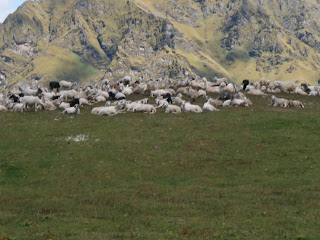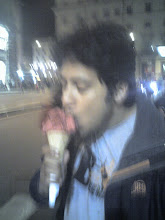The
Himalayas have managed to find a permanent place in my heart and mind
in the last two years. I have done two treks in the Garhwal Himalayas -
The Valley of Flowers trek in July 2010 and Roopkund in September this
year. These Himalayan odysseys have ensured that Uttarakhand and it's
hills always remain at the back of my mind and that I return
periodically. Even when a trek is not possible and I have only a few
days to spare on a trip up north, I always try to fit Rishikesh and some
nearby Shiva temple in the itinerary.
While the landscape, trekking opportunities and the associated folklore of Garhwal and Kumaon are unmatched, the same cannot be said about the food of the region. While I have never been disappointed with what I have eaten here - the dhabas are as good as anywhere else - the food tends to be the very simple and home-cooked type. Specialities that draw you to other parts of the country - like the Lucknowi kebabs or the Rajasthani Laal Maas - are not to be found here. Or at least I am yet to find one. No wonder then that the state of Uttarakhand has not been featured on this blog so far, despite my repeated visits/sojourns/excursions.
This year's trek to Roopkund was no exception. While the cook on the trek did an excellent job - he even made gulab jamuns in a trekkers hut at at altitude of almost 4000m!! - there was no food experience I could really blog about. There was one sight however, that set my mind racing and led to the 'plan' in the title. It's a peculiar one, I must admit and I don't know if anyone has ever thought of it or done it before. But if I manage to pull it off, it will be quite a coup.
Of the many and varied picture-perfect sights that the Himalayas have to offer, the Bugyal is one of particular touristic interest. Bugyals are vast alpine meadows located at altitudes greater than 3000 meters in Uttarakhand and Himachal Pradesh, where they are more commonly known as 'Thatch'. Bugyals are popular as camping sites during treks, but some are so picturesque that they end up being trekking destinations in themselves.
There are two such Bugyals on the Roopkund trekking route - the more picturesque Ali Bugyal and the more culturally significant Bedni Bugyal. Apart from being camping sites, they are also important pastures and are used for grazing sheep and cattle by the local shepherds. While passing through these meadows, you are sure to come across large flocks of sheep guarded by shepherd dogs. And this is where the idea hit me!
While I have been eating mutton since childhood at home and in restaurants and have also written about it on this blog, how much of it has been organic? The meat we eat in the city, probably comes from an animal raised in filthy conditions in some tiny enclosure it shares with tens of its kind. What they feed it you probably don't wanna know! Now compare that to the sheep grazing here in Ali/Bedni Bugyal. They lead far happier lives in a pollution-free part of the world, eat what is probably the best grass there is to find in unbelievably beautiful high-altitude meadows. Can you imagine what their meat will taste like? Maybe this picture will add weight to what I'm saying.
You know what? have a closer look!!
Now that I have made my point loud and clear, here's the plan. The shepherds take their flocks grazing in the meadows during the May to September season and spend the rest of the year in the villages at lower altitudes. So here is what we do.
Find a shepherd in Lohajang (base for the Roopkund trek) and strike a deal to buy one of his sheep.
Find a butcher to slaughter the sheep and do the gutting and initial preparation.
Book a suitable cottage in Almora with working kitchen and supplies.
Get the meat back from Lohajang and start cooking!! Kebabs, Raan, Mutton curry, Bheja Masala, Kaleji fry, Biryani...the works!! Even with a small sheep and a large group, it's three to four days of fabulous eating.
Sounds like a plan doesn't it? So, who's in?
While the landscape, trekking opportunities and the associated folklore of Garhwal and Kumaon are unmatched, the same cannot be said about the food of the region. While I have never been disappointed with what I have eaten here - the dhabas are as good as anywhere else - the food tends to be the very simple and home-cooked type. Specialities that draw you to other parts of the country - like the Lucknowi kebabs or the Rajasthani Laal Maas - are not to be found here. Or at least I am yet to find one. No wonder then that the state of Uttarakhand has not been featured on this blog so far, despite my repeated visits/sojourns/excursions.
This year's trek to Roopkund was no exception. While the cook on the trek did an excellent job - he even made gulab jamuns in a trekkers hut at at altitude of almost 4000m!! - there was no food experience I could really blog about. There was one sight however, that set my mind racing and led to the 'plan' in the title. It's a peculiar one, I must admit and I don't know if anyone has ever thought of it or done it before. But if I manage to pull it off, it will be quite a coup.
Of the many and varied picture-perfect sights that the Himalayas have to offer, the Bugyal is one of particular touristic interest. Bugyals are vast alpine meadows located at altitudes greater than 3000 meters in Uttarakhand and Himachal Pradesh, where they are more commonly known as 'Thatch'. Bugyals are popular as camping sites during treks, but some are so picturesque that they end up being trekking destinations in themselves.
There are two such Bugyals on the Roopkund trekking route - the more picturesque Ali Bugyal and the more culturally significant Bedni Bugyal. Apart from being camping sites, they are also important pastures and are used for grazing sheep and cattle by the local shepherds. While passing through these meadows, you are sure to come across large flocks of sheep guarded by shepherd dogs. And this is where the idea hit me!
While I have been eating mutton since childhood at home and in restaurants and have also written about it on this blog, how much of it has been organic? The meat we eat in the city, probably comes from an animal raised in filthy conditions in some tiny enclosure it shares with tens of its kind. What they feed it you probably don't wanna know! Now compare that to the sheep grazing here in Ali/Bedni Bugyal. They lead far happier lives in a pollution-free part of the world, eat what is probably the best grass there is to find in unbelievably beautiful high-altitude meadows. Can you imagine what their meat will taste like? Maybe this picture will add weight to what I'm saying.
You know what? have a closer look!!
Now that I have made my point loud and clear, here's the plan. The shepherds take their flocks grazing in the meadows during the May to September season and spend the rest of the year in the villages at lower altitudes. So here is what we do.
Find a shepherd in Lohajang (base for the Roopkund trek) and strike a deal to buy one of his sheep.
Find a butcher to slaughter the sheep and do the gutting and initial preparation.
Book a suitable cottage in Almora with working kitchen and supplies.
Get the meat back from Lohajang and start cooking!! Kebabs, Raan, Mutton curry, Bheja Masala, Kaleji fry, Biryani...the works!! Even with a small sheep and a large group, it's three to four days of fabulous eating.
Sounds like a plan doesn't it? So, who's in?



.jpg)
.jpg)
.jpg)
.jpg)



